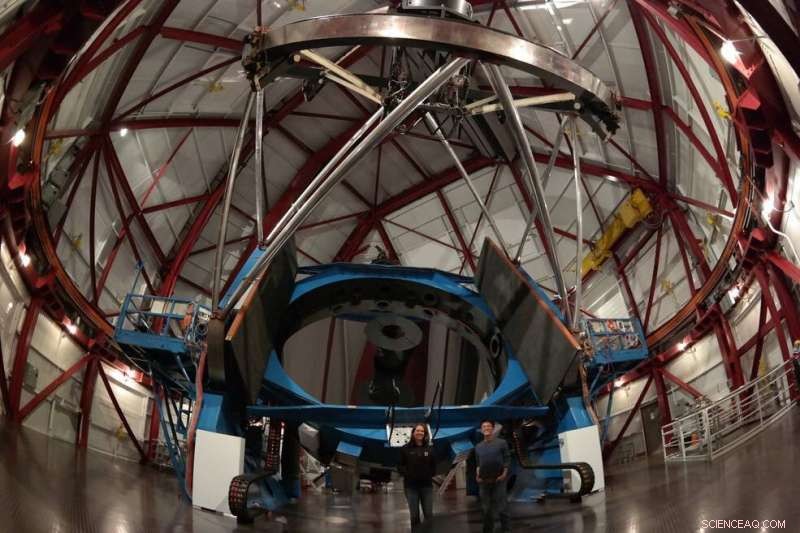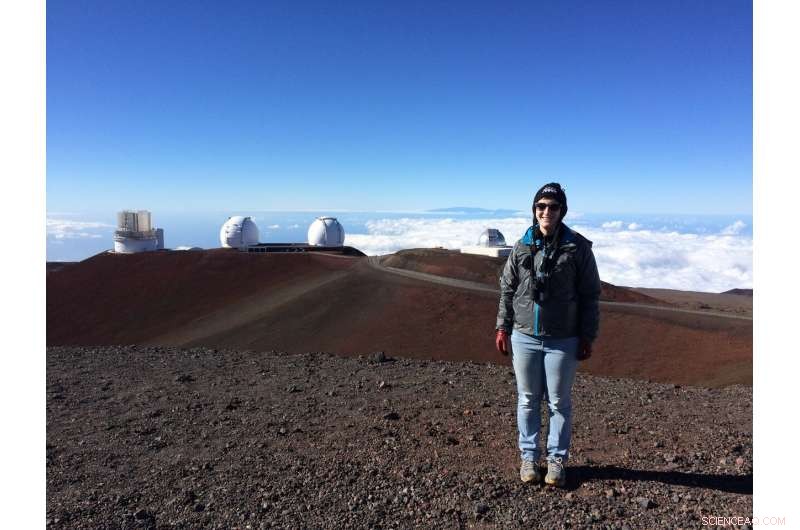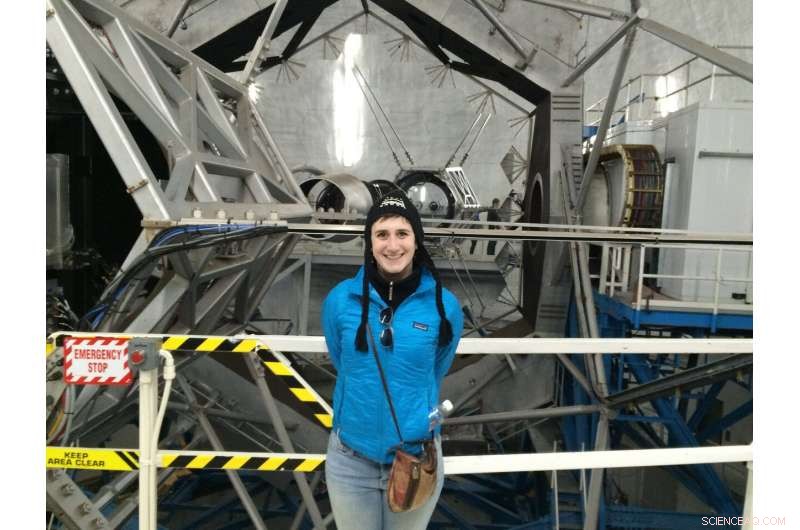
Astronomerna Johanna Teske och Alex Ji vid Magellan II-teleskopet i Chile. Kredit:Cindy Hunt
När rosa vätska sipprade runt hennes skor, astronomen Johanna Teske började må illa. Hon hade letat efter nya planeter med Planet Finder Spectrograph, ett astronomiskt instrument som liknar ett kylskåp i industriell storlek monterat på Magellan II-teleskopet. En natt i oktober 2018, en slang som leder till instrumentet sprack, orsakar att rosa kylvätska spills på känsliga delar av instrumentet och den omgivande plattformen. Skulle Teskes sökning förstöras?
Teske använder Magellan II-teleskopet vid Las Campanas-observatoriet i Chile för att lokalisera planeter utanför vårt solsystem, eller exoplaneter, och ta reda på vad de är gjorda av. Hittills, fler än 4, 000 exoplaneter har upptäckts, men vetenskapen har visat att det måste finnas miljarder, eller till och med biljoner, bara i vår galax. NASA:s nyaste planetjägare, Transiting Exoplanet Survey Satellite (TESS), söker efter möjliga planeter runt närliggande ljusa stjärnor.
Många team av forskare runt om i världen söker för närvarande igenom TESS-data, att välja stjärnor som kan vara lovande att observera från marken och boka tid vid kraftfulla teleskop för att följa upp nya planetkandidater. Tävlingen pågår för att se vilken av dessa TESS-signaler som representerar någon slags bedragare, och som pekar på riktigt nya världar.
Som NASA Hubble-postdoktor vid Carnegie Observatories i Pasadena, Kalifornien, Teske var exalterad över att vara med i detta lopp. Hennes grupp fick NASA-medel för att leta efter planeter med tre gånger jordens radie eller mindre, som skulle inkludera udda planeter som kallas "superjordar". Superjordar tros vara steniga som jorden, men något större än vår planet. I oktober 2018, Teske och kollegor påbörjade TESS-uppföljningsobservationer för första gången. Men ungefär mitt i deras två veckor långa löpning, under deras klaraste natt, röret sprack.
Kan röret fixas och röran städas upp snart nog för att spara resten av Teskes observationstid? Skulle hon och hennes team samla in värdefull information om exoplaneter?
Varför planetjakt från jorden är viktigt
Teskes dramatiska natt i Chile är inte typisk, men illustrerar hur sökandet efter exoplaneter från marken kan bli komplicerat av jordiska bekymmer. Förutom enstaka mekaniska problem, astronomer måste kämpa med vind, regn, snö, moln och allmän atmosfärisk turbulens – vilka som helst kan förstöra en hel natt med skyskådning. Månen erbjuder också utmaningar:Medan TESS-stjärnor i allmänhet är ljusa och kan observeras under "ljus tid" - det vill säga, när månen är ungefär tre fjärdedelar full – astronomer som tittar på mycket svaga stjärnor eller andra galaxer måste vänta på "mörk tid" när det finns lite eller inget månsken. Och, eftersom astronomer bara kan observera på natten, de måste avstå från att sova under timmar av dyrbart mörker.
Men markbaserade teleskop är avgörande för att bekräfta existensen av planeter som TESS och andra rymdteleskop hittar, och för att lära dig mer om dem. TESS, som den rymdbaserade planetjägaren Kepler, vars uppdrag avslutades 2018, stirrar på stjärnor under perioder, mäter hur ljus stjärnan är med några minuters mellanrum i veckor i taget. En nedgång i ljusstyrkan kan representera en händelse som kallas "transit, " där en planet passerar framför sin stjärna. Men sänkningen kan lika gärna komma från en annan stjärna, eller vara en annan typ av transientfenomen som uppstår på stjärnan eller inom detektorelektroniken.
Forskare måste vända sig till markbaserade teleskop för att ta reda på detta. När Kepler skickade tillbaka data som tydde på tusentals nya planeter, astronomer organiserade sig för att följa upp dem, för. Resultaten ledde till insikten att det finns fler planeter än stjärnor i Vintergatan.
"Ljusstyrkemätningarna från rymdfarkosten är bara det första steget, sa David Ciardi, astronom vid California Institute of Technology, Pasadena. "Du behöver ett dedikerat markprogram för att undersöka och klargöra vad du ser. Utan markdata, du kan inte förstå vad TESS har sett."
I vissa fall, there may be data collected from a star in years past that contain the information necessary to confirm a planet candidate—such as in the case of TESS's first confirmed planet Pi Mensae c. Annat, astronomers need fresh observations to learn all they can about these alien worlds.
And because they are accessible to human hands, ground-based telescopes can be upgraded, fixed and re-tooled much more easily than space observatories. I vissa fall, ground-based telescopes have higher resolution for taking images of stars than space telescopes.
"We have a lot of questions about every single planet, " said Lauren Weiss, the Parrent Postdoctoral Fellow at the University of Hawaii at Manoa. "There are a lot of small planets that we're really excited about, but in order to answer all of these questions, we have to use a variety of new tools and techniques."

Astronomer Lauren Weiss at the W. M. Keck Observatory in Hawaii. Credit:B.J. Fulton
Ground-based follow-up is more critical than ever now that astronomers are gearing up for NASA's upcoming James Webb Space Telescope, which will study exoplanet atmospheres with greater sensitivity than any observatory yet. Webb will look for the fingerprints of chemicals in exoplanet atmospheres, including those allowing life as we know it to thrive. But because Webb will target many different scientific questions about the universe, it will only have a portion of its time for looking at exoplanets. Astronomers need to start finding the most promising targets now so that they're ready to explore them further as soon as Webb starts operating.
But first, scientists need to be sure those planets are really there.
What Ground-Based Telescopes Do
One of the first facts a scientist needs to know about a possible exoplanet is:Which star does the planet orbit? This fundamental puzzle piece isn't immediately obvious from telescope data because all astronomers can see are individual pixels from the telescope camera, each corresponding to an area of the sky. If two stars appear extremely close to each other in these data, it may not be obvious which star seems to be dimming because of a transiting planet.
"The ground-based efforts can determine which star is the source of the signal, " said Knicole Colon, astronomer at NASA's Goddard Space Flight Center in Greenbelt, Maryland. "That's absolutely a major part of the ground-based follow-up:Which star is the host?"
Sedan, there's a separate process of getting the mass of the planet. No one can put a planet on a scale. But a planet's mass is often determined through the "radial velocity method", or looking at how the star wobbles ever so slightly in response to the gravity of its planets. För närvarande, only ground-based telescopes are capable of exoplanet radial velocity measurements. Carnegie's Planet Finder Spectrograph, which Teske uses at Las Campanas in Chile, is just one instrument that can determine a planet's mass. The forthcoming NEID spectrograph, a collaboration between NASA and the National Science Foundation, at Kitt Peak Observatory in Arizona, is another example.
The mass of a planet is different from its size, which refers to its diameter. Scientists measure diameter by looking at how much the brightness of the host star dims during the transit.
Combining the size and the mass of the planet, scientists can determine its density—a big indicator of whether it is rocky, like Earth, gaseous, like Jupiter, or something in between, which would be unlike any of the planets we have in our solar system.
Astronomers also use Earth-based telescopes to thoroughly study the stars themselves to determine planet properties. Any size or mass measurement of a planet can only be calculated relative to the size and mass of its host star. And if the star is part of a double-star or multi-star system, that could change the calculations entirely unless astronomers can determine the fraction of light originating from other nearby stars, and factor it into their calculations.
With so many different properties of star and planet observations to consider, it often takes large groups of scientists working with different instruments to arrive at even a basic understanding of a planetary system.
"That's why these teams are so big, " Weiss said. "Each of us has to address a very specific question, or set of questions, related to the validity of the planetary hypothesis, and the fundamental properties of the star and planet."
A planet that Weiss helped discover, TOI-197b (also called HD 221416b), is a particularly good example of how a giant collaboration of people using observatories in space and on the ground can paint a picture of a new world. The study announcing it to the world, published in April 2019, was authored by more than 100 people representing five different continents. Astronomers found out a lot about the age and radius and mass of the star because of the special way they have been able to examine its properties.
"The star is ringing like a bell from internal pressure waves and gravity waves inside the star, " Weiss said. The study of these waves, called asteroseismology, is a powerful tool for characterizing a star.

Astronomer Lauren Weiss looks at planets outside our solar system using the Keck Telescope in Hawaii. Credit:B.J. Fulton
Multiple observatories worldwide including Keck Observatory at Mauna Kea in Hawaii, where Weiss was situated, contributed observations. Dan Huber, huvudförfattaren, wrangled all of the different datasets together. Ashley Chontos at the University of Hawaii created a model to reconcile both the transit and radial velocity measurements. By matching their model to the observations, astronomers were able to put together a picture of the planet that could explain all of these different signals seen in all of the different telescopes.
Astronomers found that, at 63 times the mass of Earth, this planet is a little bit denser than Saturn. But they call it a "hot Saturn" because its orbit around its star is only 14 days (by contrast, Saturn makes a loop around our Sun every 29 years). There is nothing quite like it in our solar system.
A New Planet, and Even Another
Så, what happened with Teske's planet search after the burst pipe incident at Las Campanas? The search for new planets motivated her to snap into action. "Pretty quickly I moved into 'how do we fix' this mode, " she recalled. "It was a big team effort for sure."
Lyckligtvis, the observatory staff was able to resolve the issue in a few hours. After they finished mopping and carefully checked over the instrument, Teske and colleagues resumed their exploration of exoplanets that very night, and continued for the rest of their scheduled week. Despite overnight observing for about two weeks during the telescope run, Teske didn't go home to Pasadena afterwards—she boarded a plane for Washington, D.C., where she ran a marathon.
Their observations from that trip helped scientists determine the mass of a planet around a star called HD 21749 or GJ 143. This so-called "sub-Neptune" planet is about 2.6 times the diameter of Earth and likely gaseous, but smaller than any gas giant in our solar system.
Combining the Las Campanas observations with data from TESS and archival data from the HARPS instrument at La Silla, Chile, astronomers were able to confirm this exoplanet and determine its mass, which is more than 20 times that of Earth.
"While we were looking at the data for that planet, we found that there is another planet in the same system around the same star; it's about Earth's size, " said Diana Dragomir, also a NASA Hubble Postdoctoral Fellow at MIT who was the first author on a study of this system, and part of the observing team with Teske at Las Campanas. "It's a nice demonstration that TESS can indeed find Earth-size planets."
During the same observing run, Teske and colleagues also got some measurements of Pi Mensae c, the very first planet confirmed in TESS data, that may help get a better handle on its mass. With more data left to sift through, discoveries may be yet to come from that same observing run in October 2018.
Since TESS recently turned its gaze to the northern hemisphere of the sky, the Chilean telescopes will be out of range for much of the next batch of data. That gives Teske and collaborators time to go back through what they've done so far, and figure out which southern TESS stars they want to keep following over the next two years. Their goal is to find out more about super-Earth and sub-Neptune exoplanet populations by establishing masses for such planets as precisely as possible.
At nearly 8, 000 feet up, Las Campanas isn't high enough to make Teske feel dizzy from the altitude, but high enough that she might get out of breath from walking fast. A variety of wildlife, like foxes and rabbit-like animals called viscachas, sometimes approach the dome as Teske and her collaborators explore the galaxy. She knew she wanted to be an astronomer around age 10 or 11 when she saw the movie "Contact, " based on the book by Carl Sagan, and related to the main character's drive and curiosity. I dag, observing in Chile is one of Teske's favorite parts of her job.
"I am getting to see things that no one else is seeing. It's quiet, and it's just me and the stars, " Teske said. "I hesitate to use the word 'magical'—but it's analogous to that."